Mission Green Munia
- With JungleHike Tours
- October, 2022
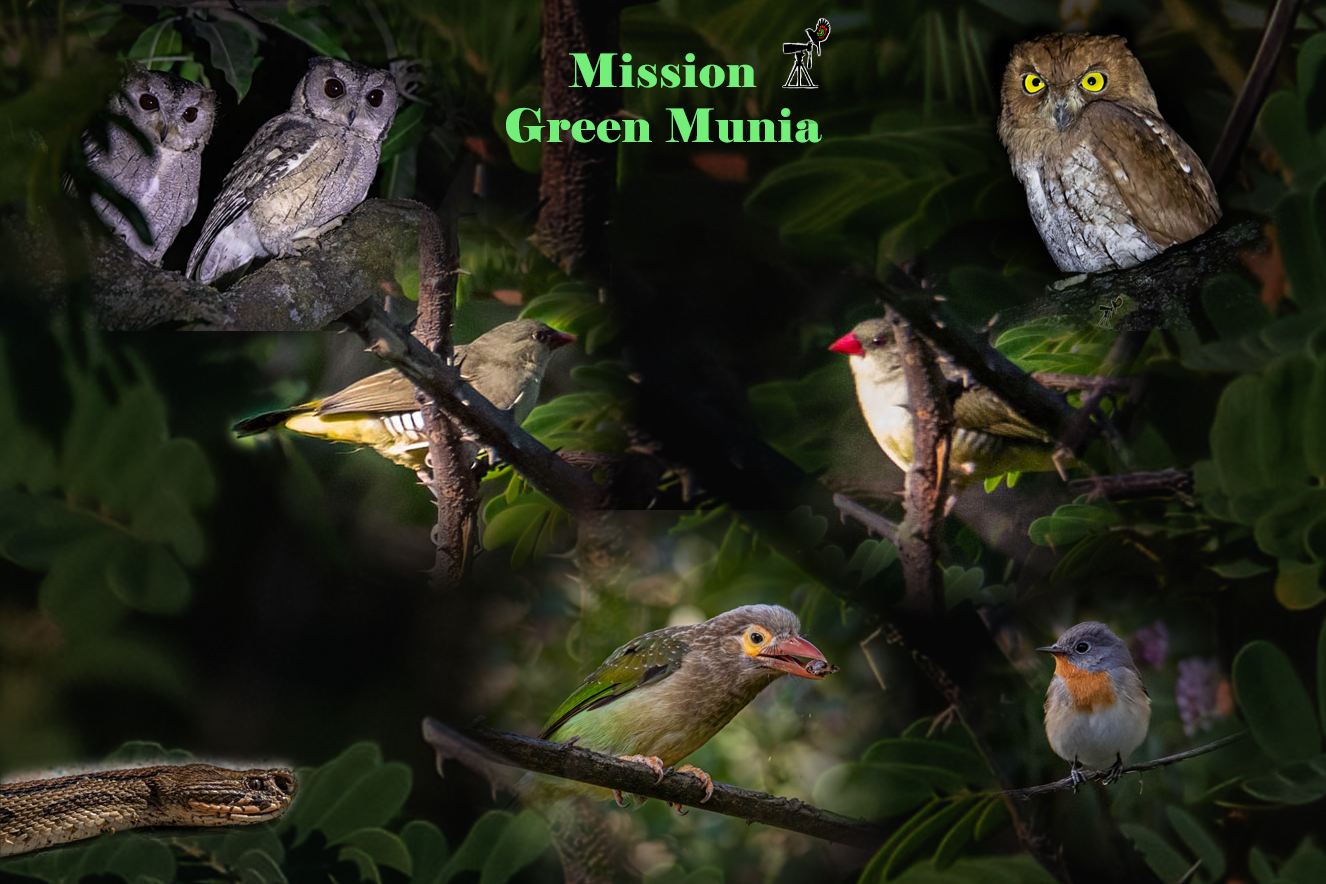
Prologue ...
Mount Abu is a famous hill station in Rajasthan (bordering Gujarat) but it was on my radar for being a Green Munia destination. A close cousin of the Red Munia, this species seems to be only seen in those hills (there are a few sporadic records in other parts of India but this was the most common destination for birders).
JungleHike announced this trip as a combination of Nalsarovar and Abu. Mid-October is not that good a season for Nalsarovar so I was a little skeptical, to begin with, but then I decided to take it anyway. All along, the idea was to target Green Munia. Anything seen in Nalsarovar would be a bonus.
Journey to Ahmedabad
As I understand, Nalsarovar was once only the lake birding but over the last few years, the guides there have found a lot of surrounding birding locations, and considering its proximity to Ahmedabad, it is an accessible location even for the Mumbai birders. A lot of birders take an overnight train to Ahmedabad, spend just a day in Nalsarovar and take the night train back to Mumbai (just a day + 2-night travel).
And whenever there is any news of rare sightings around Nalsarovar, birders do this routine regularly.
We had also planned an overnight journey from Bandra Terminus but there was a slight twist for us. We were scheduled to reach Ahmedabad by 6:30 am and we had a decent night's sleep on the rail berths. I had my alarm for 6 but got up a little earlier. Little later our train had an unscheduled stop at the Mahemadavad Kheda station. And then, the halt just continued... 5,10,15 minutes, there was no sign of the train starting again. We even went down and had tea there. Normally, you see a train coming from the opposite side passing thru, and you think that would have cleared the track but trains kept coming from the opposite end and we continued to remain stationary (literally).
Then came the news about an overhead wire issue further ahead on the track. This could mean a big delay thereby putting a big spanner on our day plan for birding. One option was to call out vehicles to this station instead of Ahmedabad as this was about 50 minute's drive from the city (as per Google Maps). One good thing was we could have then proceeded directly towards Nalsarovar (and would have avoided the Ahmedabad city traffic). After some discussion, we decided to get down. The overhead bridge was unfortunately at the other end of the platform. We all slowly walked the distance and climbed the bridge and as we were getting down to the other end, there was an announcement in Gujarati. It was about the train to Ahmedabad starting … There was no way we could have reached back to the train, so we moved out of the station and waited for our vehicles. In that process, we lost a couple of hours of birding time anyway.
After waiting about half-hour, our vehicles came to the station and we started our journey towards Nalsarovar. Our guide Memud-bhai was waiting at a particular spot in Bavla, but before that, we quickly had a typical Gujarati breakfast of fafda, dhokla, and Chai at a roadside eatery.
Memud-bhai then took us to a field where the Sarus crane pair was sighted. It was 11 am and the light was too harsh by then. Even the cranes had moved deep into the fields but we had to make do with that.
In the same field, we saw a flock of Black-tailed Godwits. Close by we also spotted a bunch of Glossy Ibis. Although not many of the migratory birds have arrived here, with little close watch one could still see a few other species.


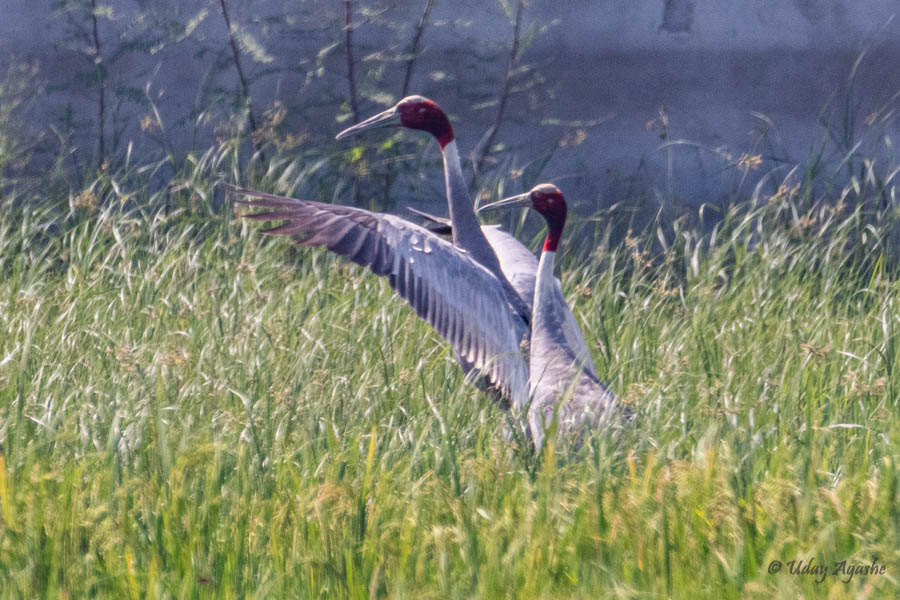
As I have mentioned earlier, the birding season is not yet on and that meant we would search for whatever we could find around (nothing specific). With the help of Memud bhai we roamed around the area, keeping our eyes open as we moved ahead.
Little ahead, Sowmya saw something like an owl on a tree adjacent to the road. It was indeed the Spotted Owlet. Well awake and looking at us curiously. Just ahead we got a glimpse of the tri-colored munia but she quickly went into dense vegetation not allowing us a good photo opportunity
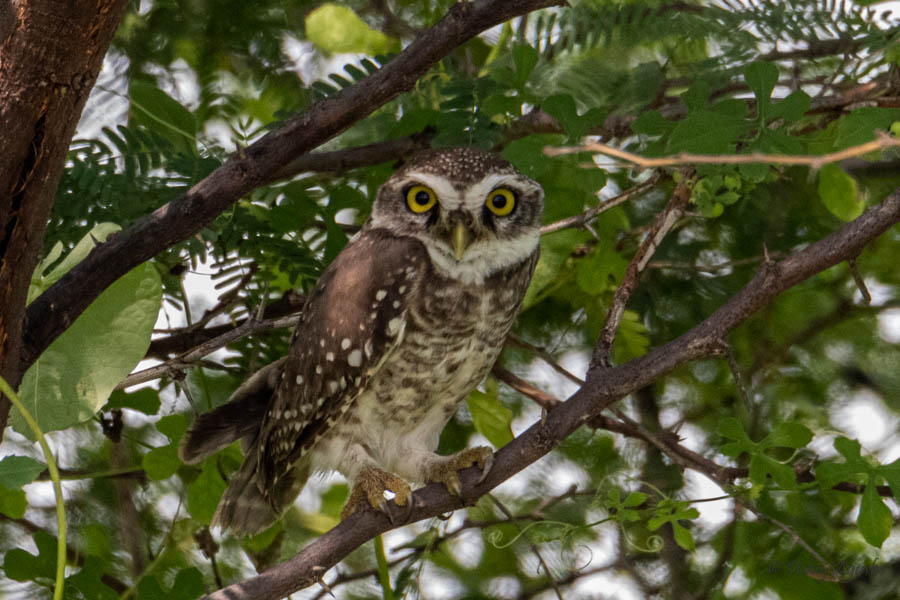

We then saw the beautiful Pheasant-tailed Jacana (as it was the end of its breeding season, the long tail was unfortunately missing). We could take a few photos from a relatively close distance. But just as we were observing the reeds in that water body. We noticed a brown crake moving speedily, Avinash was then closely watching every movement in those reeds. Not the brown crake, but we spotted the Baillon’s crake in the little opening. It kept playing hide-n-seek with us for the next 10 minutes and eventually settled at a position that was visible to us thru the reeds.
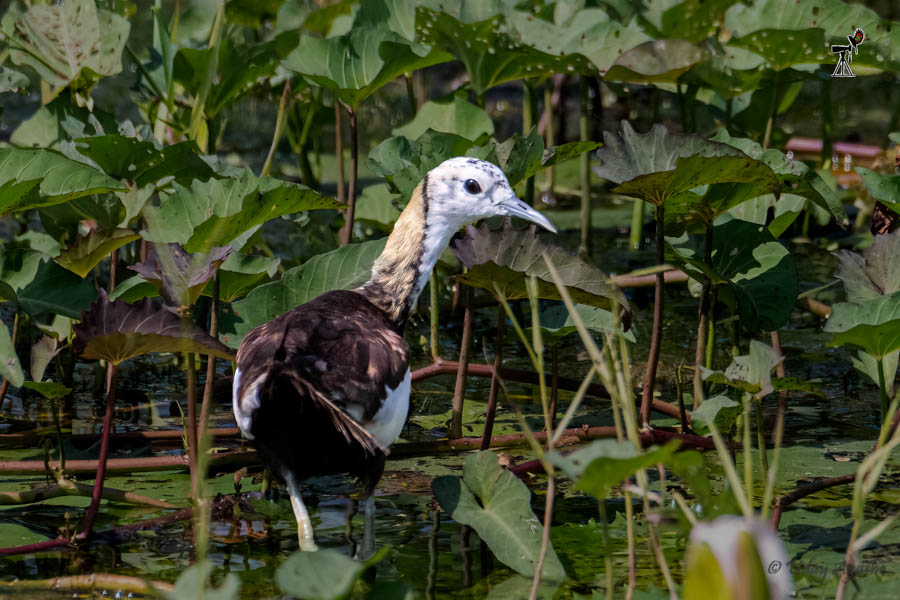
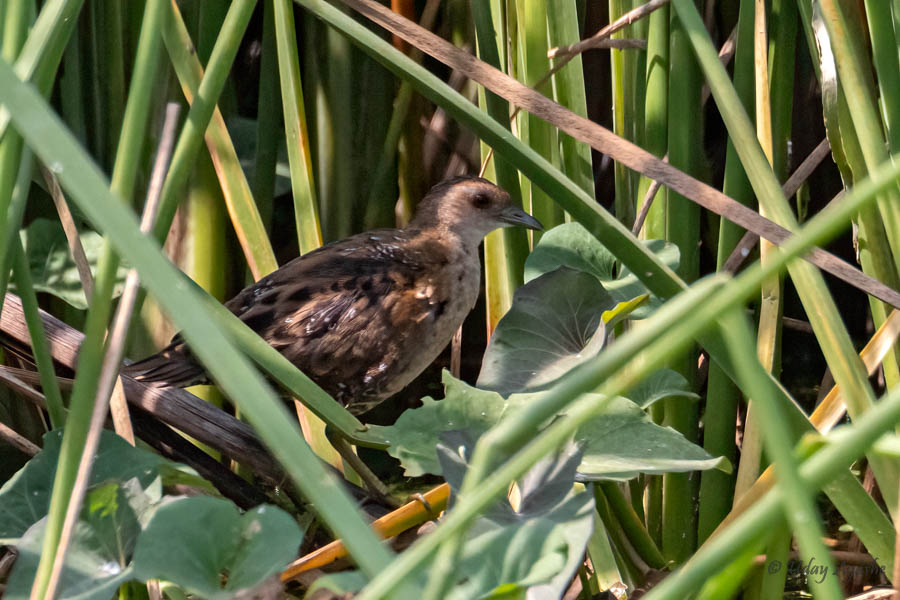
Although not too many birds, we did see a few. First were the 2 kingfishers (common as well as pied), then came a nice chase sequence of the Greater-spotted Eagle (fulvescens morph). It was being chased by a Harrier way up in the sky, we could also locate an Osprey carrying a big fish in its talons.
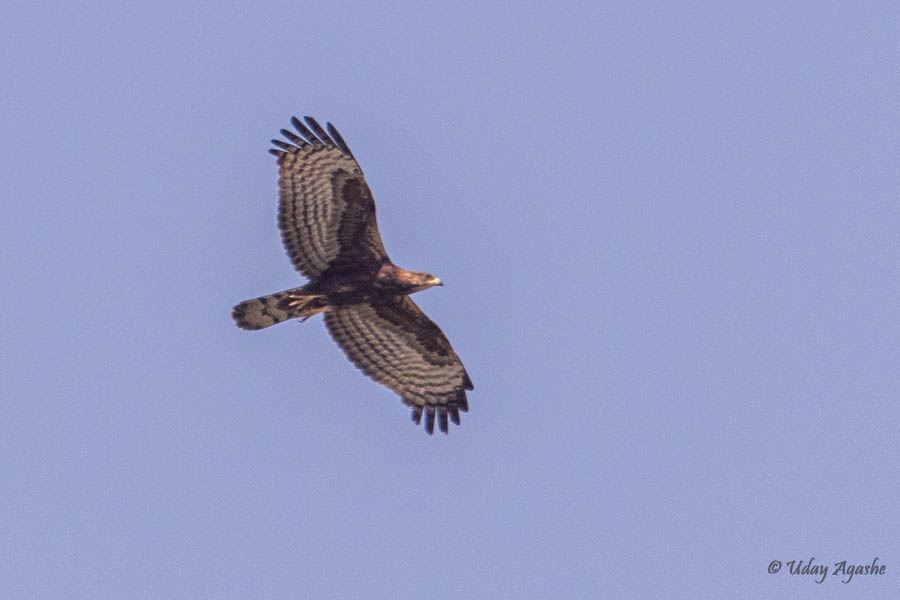
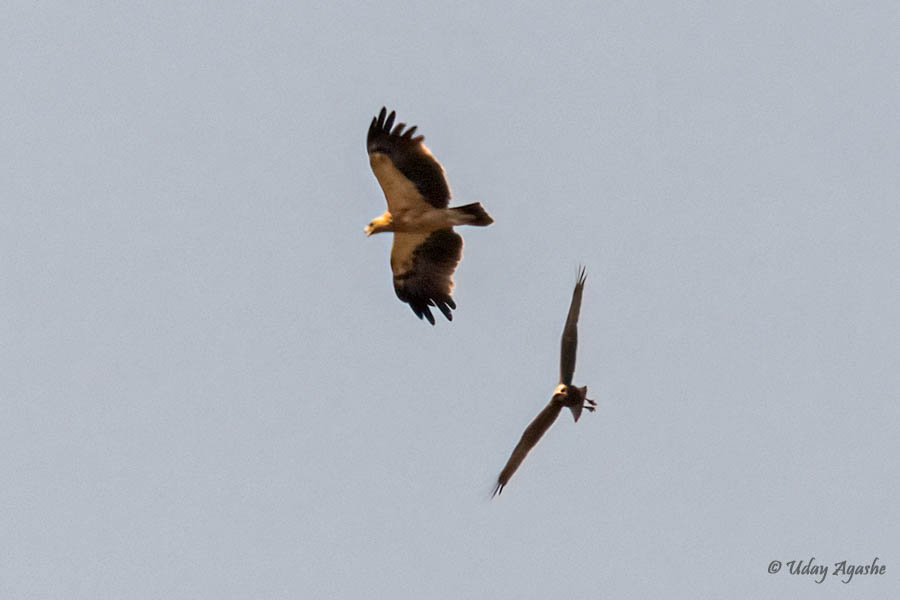
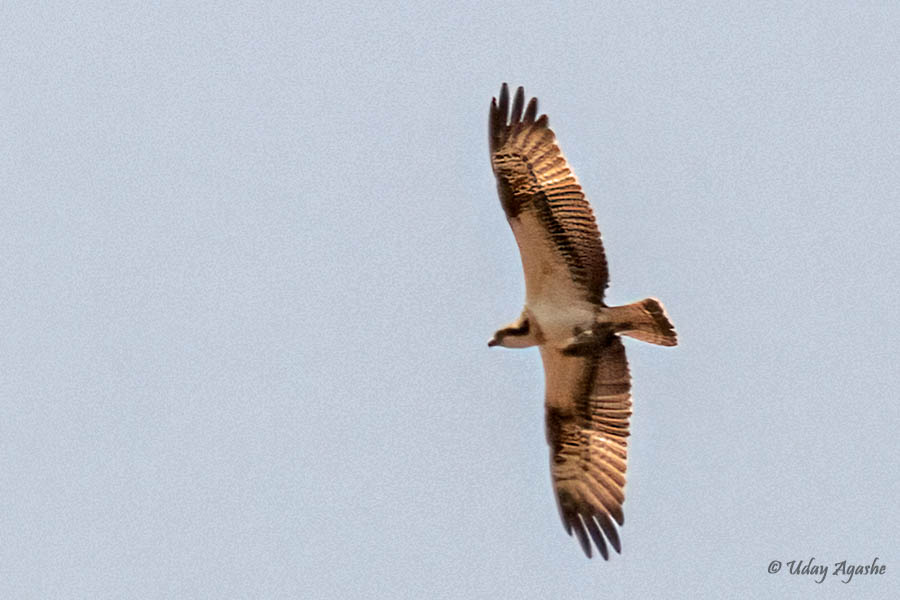
It was already 1 pm and time for the lunch break (we didn’t realize it because of birding, but as we approached the restaurant, we could feel the hunger).
Lunch was a simple local thali that was enjoyed all along with glasses of cold Chhas. After lunch, we spent an hour in the restaurant area itself (too hot to move out during those hours for birding, and our hotel was way too far to go and come back for evening birding).
By 4 o clock, we started our birding (after a nice hot tea at the famous crossroads near the entrance of the Nalsarovar sanctuary.
We were immediately greeted by a small group of open-billed storks and a lone Glossy Ibis (they are normally seen in flocks).
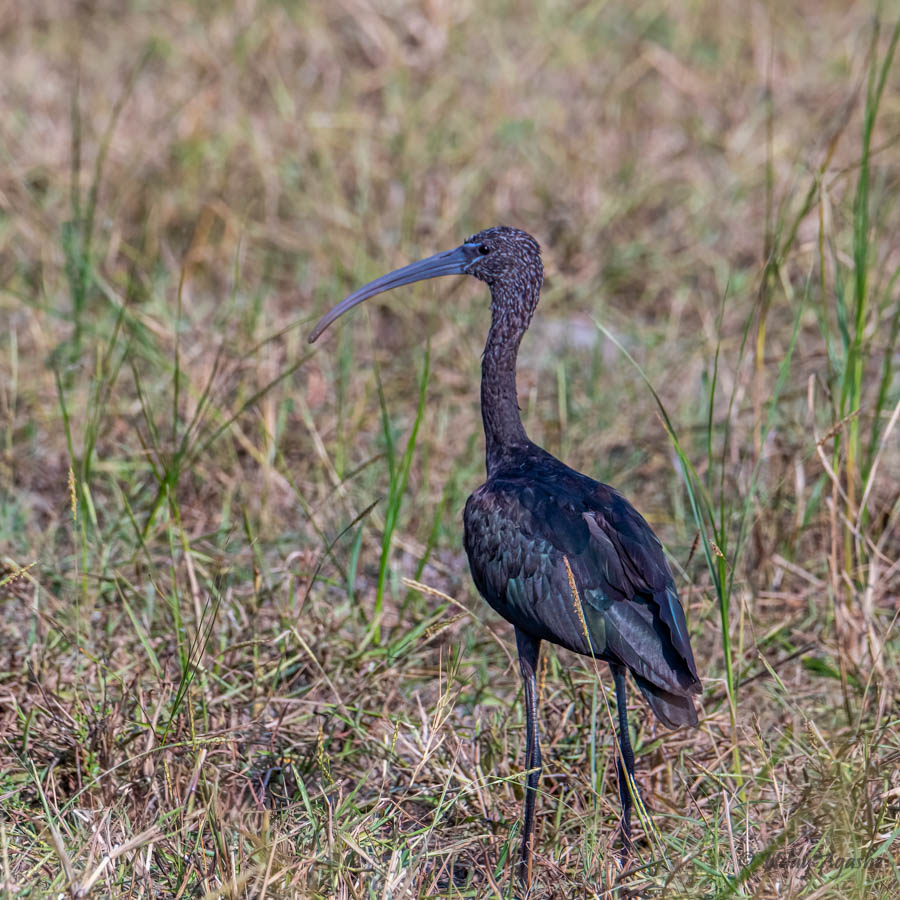
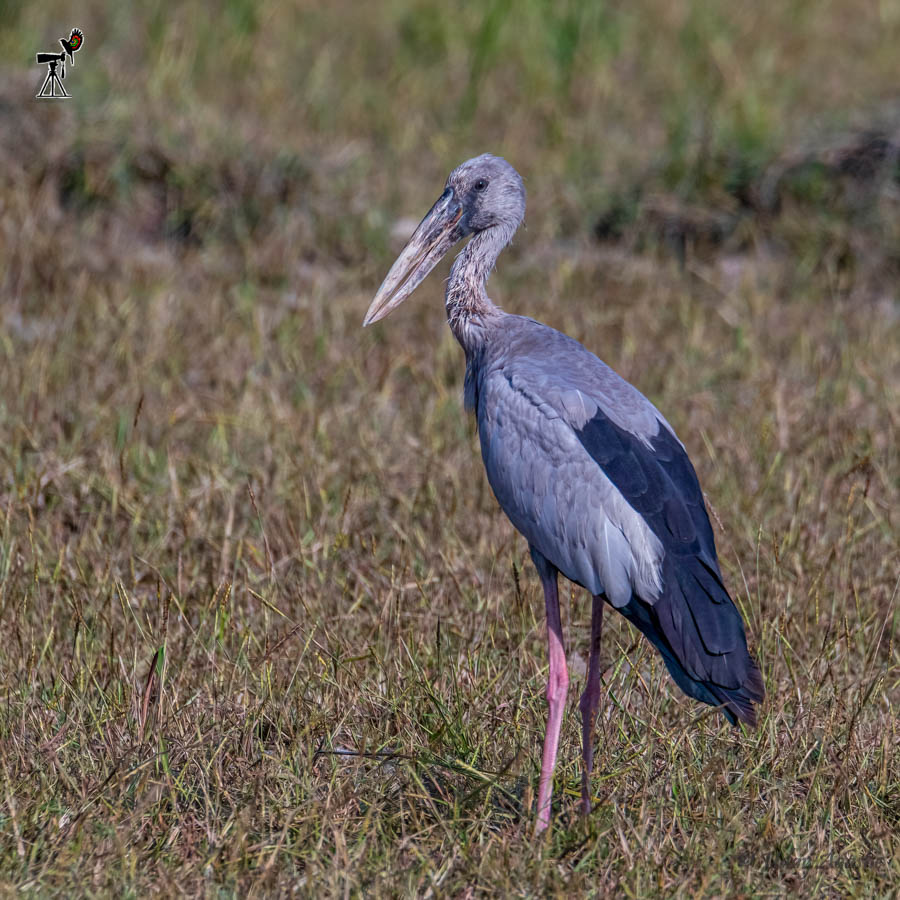
After that, we parked our vehicles and decided to go walking into the grassland with sandy patches and shrubs. As we started watching closely, we could see a lot of small birds around. I was able to capture some of the noticeable ones like the Siberian Stonechat, Bay-backed Shrikes, Indian Silver-bills, Rufous-fronted Prinia (we could see an adult together with a juvenile), and a Delicate Prinia carrying a small butterfly kill in its mouth.
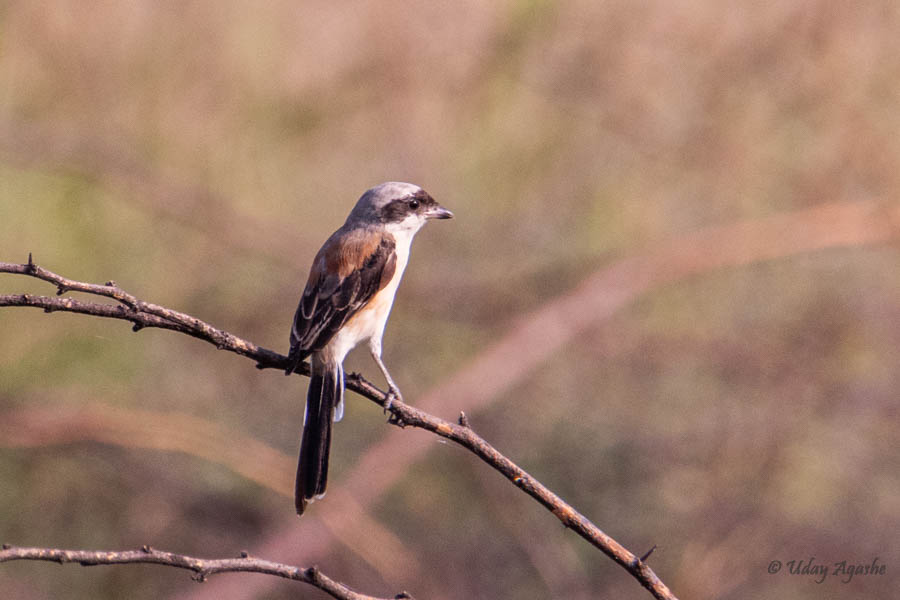
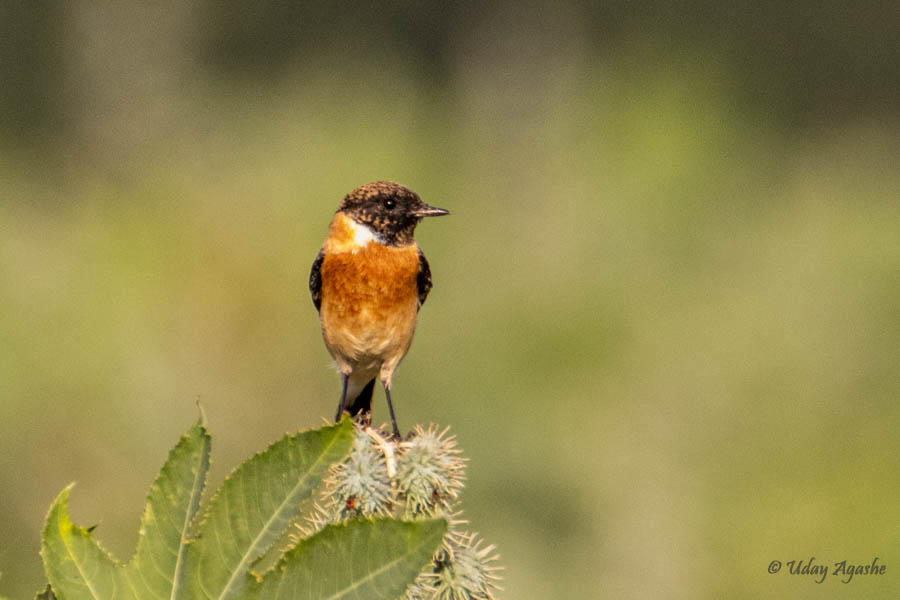
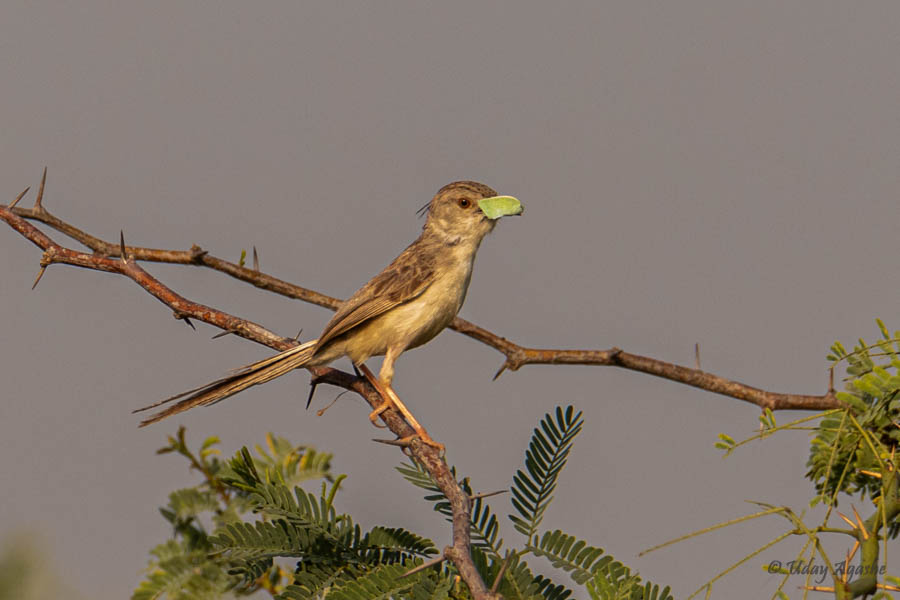
As we continued our walk, suddenly a small flock of Chestnut-bellied Sandgrouse flew away. Typically, they are so well camouflaged in the surroundings, it is difficult to see them unless they make such a move. The usual grassland birds like Ashy-crowned Sparrow-larks and Paddy-field pipits were also seen.
On the way back to our vehicles at one point, Avinash heard the call of Barred Buttonquail. He immediately assembled all of us and asked us to be quiet, in anticipation of its possible movement in the open area. We waited for about 10 minutes and the quail did come out for a quick stroll. Just managed to take a few shots before it disappeared into the thickets.

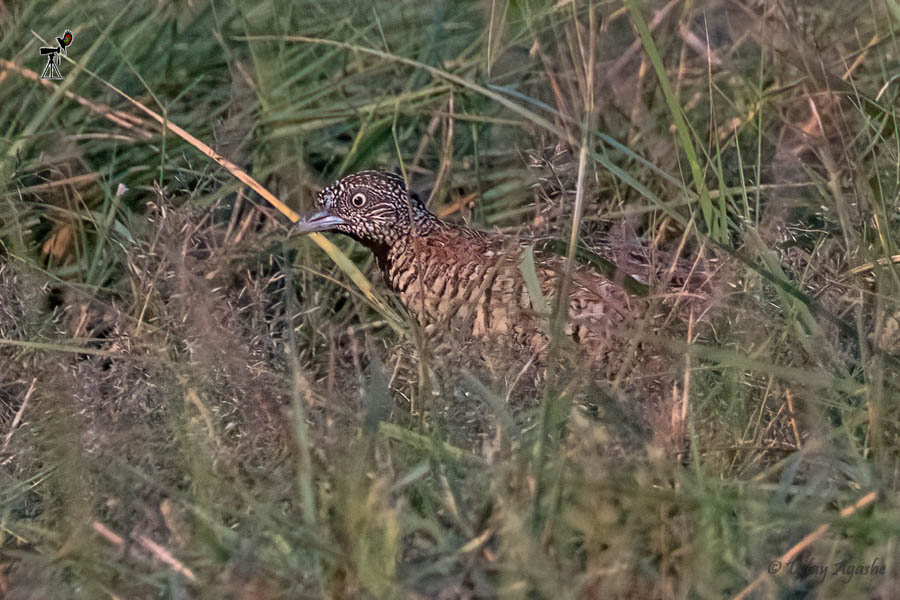
It was about 6 pm and we all decided to head for the hotel (we were traveling since the previous night and all of us were tired). Just as we started our journey back, we saw the brown shrike. Although it is not a rarity, in this region at this time it is uncommon. Sometime before, we had also seen the bay-backed shrike. These birds are known as Butcher birds, because of the peculiar way in which they impale their prey onto the thick thorns.
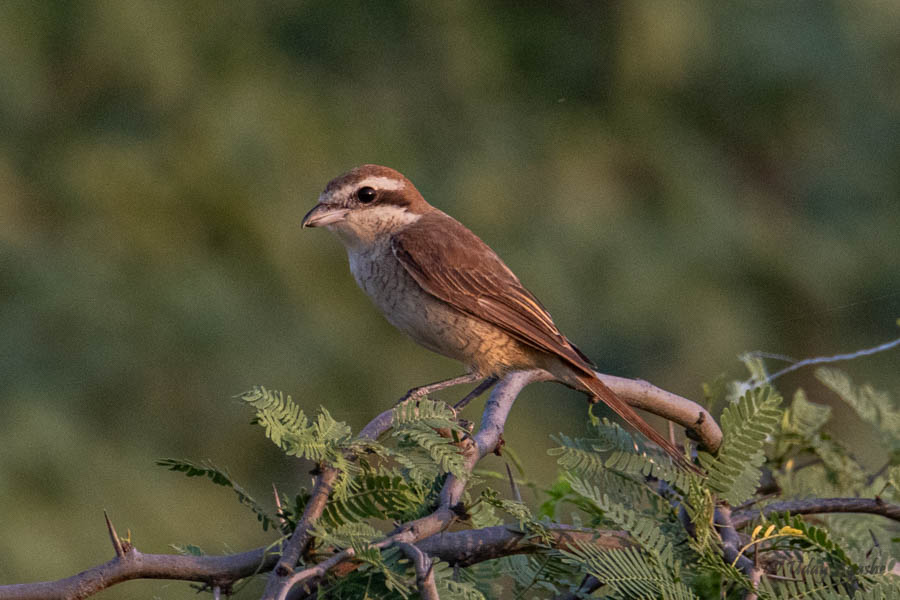
We still had a long journey (more than an hour) as our hotel was near Sanand town. By about 8 pm, we were at Hotel Benediction (especially mentioning the name here, just do not ever stay here). We had once stayed here earlier and the experience then was very bad. Although they had promised a recent renovation, the rooms were the same. Anyway, thankfully we had to just spend the night there.
The Nalsarovar Boat Ride
In the morning, we decided to take a boat ride on the Nalsarovar lake. There is an official entry point for the lake from where the government-run boats can be taken. But we went to the other side of the lake and took the boats from a distant village. These are small boats that are maneuvered using a long bamboo stick (as the water is not very deep, they can use it effectively).
This year although there has been more rain in most of India, this region had less rainfall. Due to this, the water levels weren’t deep and a lot of small islands can be seen in the lake area. We had to keep our vehicles at some distance and walk towards the boat.
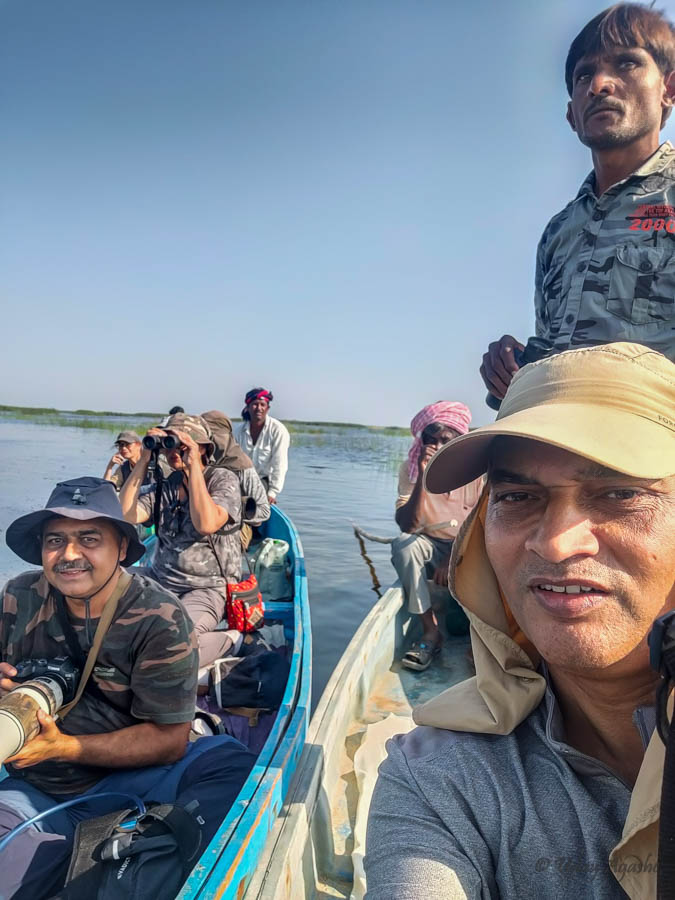
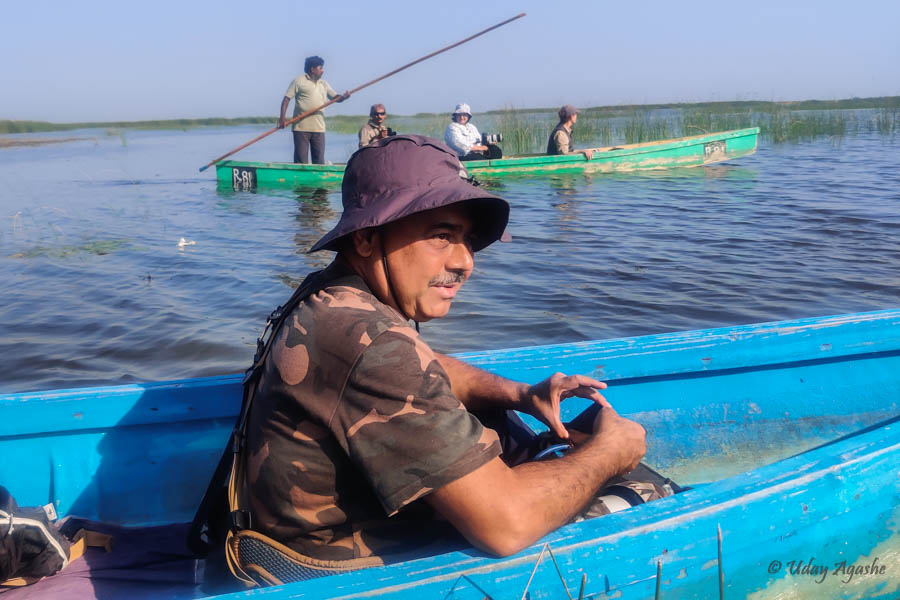
Our primary target was the collared pratincole which is not very common in other parts of India. As such it was a little early for the migration season, so there weren’t any ducks (and other waders) around anyway.
As we moved into the waters, our guide located the Pacific Golden Plovers at some distance. In a moving boat, it is a little difficult to take photos because of the shaky movements. Add to it, the boat cannot be stopped anywhere like a vehicle on road. There is only a little that the boatman can do. With that limitation, we reached as close as possible and took a few shots.


Besides the plovers, we were able to see the Black-winged Stilts, the Glossy Ibises, the terns (little, whiskered, and River), and egrets. We could also see the Blue-tailed Bee-eaters but they were too far for any meaningful photograph. One noticeable thing was there were many Marsh Harriers as well as Purple Herons (the only problem was they were flying away in opposite direction)
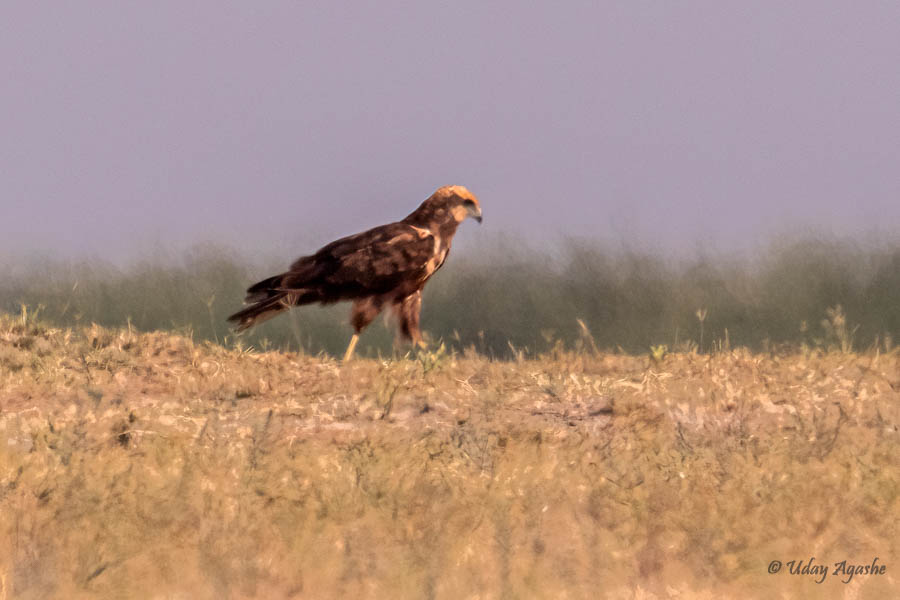
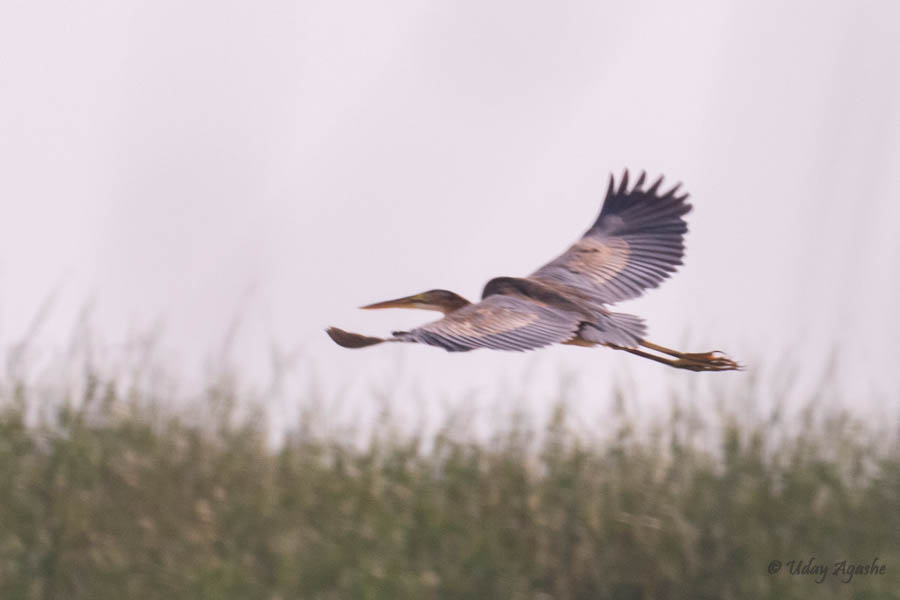
Little later we decided to take a halt at a small island. On this island, our guide spotted the Collared Pratincoles a few days back. We got down with enthusiasm and roamed the small land all over (but there were no signs of the pratincoles, technically we did see 3 of them flying over us though).
Well, not the collared variety but we could spot 5 small pratincoles. They were so well camouflaged in the grass/sand, it took us a lot of time to see them, that too with the help of our guide’s location references.
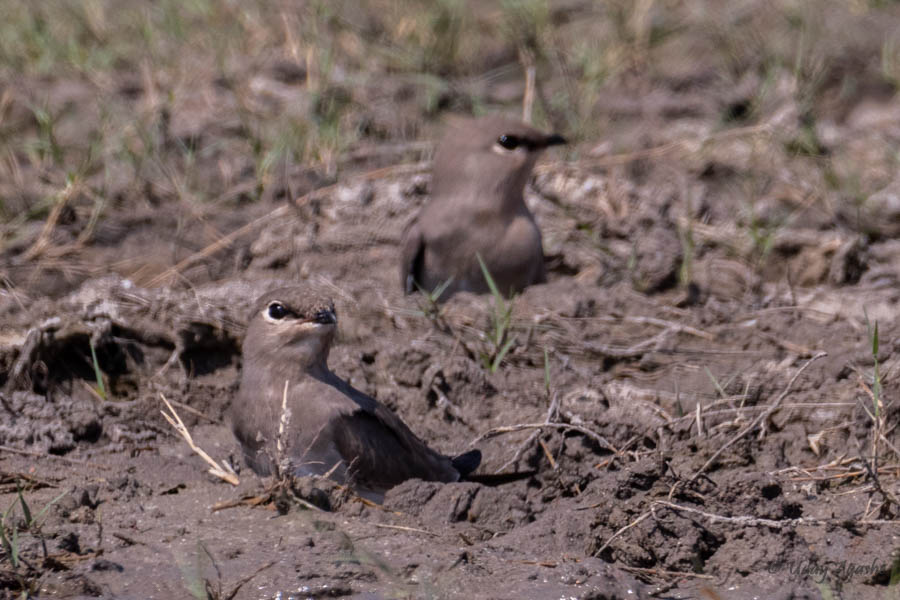
We continued our search for pratincoles and even visited one more island on the way but there were no signs of them and it was getting too hot. By noon, we were back on the mainland. Our bags were already packed (and were inside our vehicles). For the Nalsarovar portion of our trip, the 8 of us were traveling in 2 Ertigas but the journey towards Mount Abu was to be covered in a Tempo Traveler. It was waiting for us at Sanand. By the time we reached the spot, it was about 1:30 pm. We quickly transferred our baggage to the larger vehicles and had our lunch.
The journey from Sanand to Mount Abu was for 5-6 hours and on the way, there were 2 possible tourist destinations that we could have visited. One was the Modhera Sun temple and the other was “Rani ki Vav” but both these places close down by 5:30. Because of our extended boat ride, we were not likely to make it to either of these places before 5 pm, so we skipped the plan and decided to head straight to the destination.
We just had one break and by about 8/8:30 we reached our homestay villa in Oriya village. This village is further higher than Mount Abu town on the hills. 3 of our fellow participants had already reached the place in the afternoon, they were waiting for us for dinner.
This place had good rooms (4 each on the 1st and 2nd floors) but the toilets were outside in a common area. Even the terrace had a nice sit-out and we chose that for the dinner.

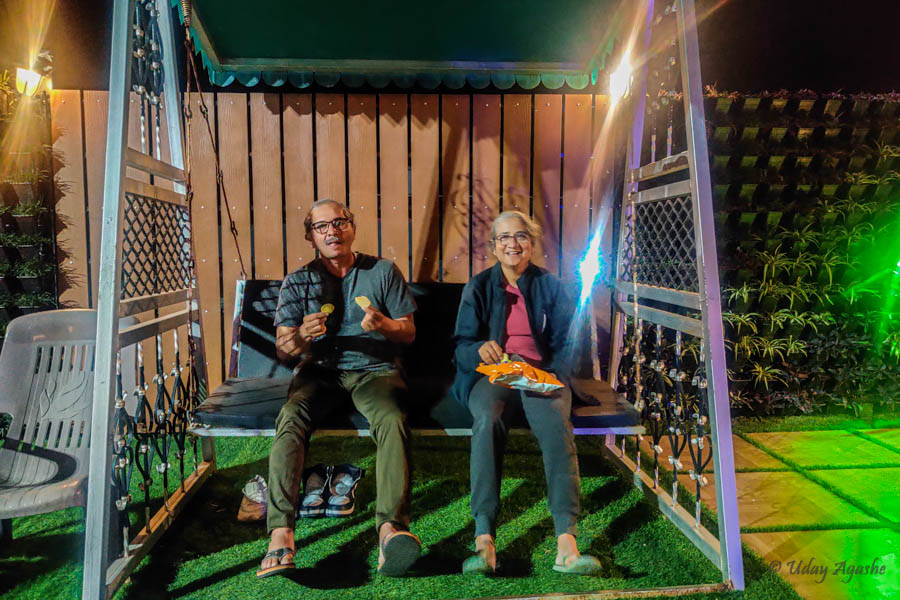

Just as we were having dinner, Avinash noticed the calls of the Oriental Scops owl. So he declared the intention of exploring it at night. Although all of us were tired everyone was ready for the chance of seeing the owls.
Our homestay caretaker then decided to accompany us. The reason for that was also the danger of Sloth Bears, he was well aware of the bear risk and was with us to ensure we don’t venture into any dangerous territory. He then took us near a temple (Aja Mata Temple), the back side of which was a thick jungle area.
This looked to be a promising one as we could all hear the owl's calls. Within no time, the owl came and sat on a tree near us. It so happened that none of us were carrying cameras, so we all were happy just watching it on the torchlight. But we all decided to visit this place again the next night. With that resolve, we got back to the rooms and quickly got into the beds for the much-needed rest.
Mission Munia Begins
We planned to start the day a little late (compared to what we do on the typical birding trips) as we had a walking trail that morning in the nearby areas within the Oriya village (Based on Avinash’s experience for last so many years, they can be easily seen nearby).
But before going out, we decided to do some terrace birding as there was a fruiting tree close to our homestay. As expected, we started at 6:30 and were able to see the flowerpeckers, coppersmith barbets, and bulbuls.

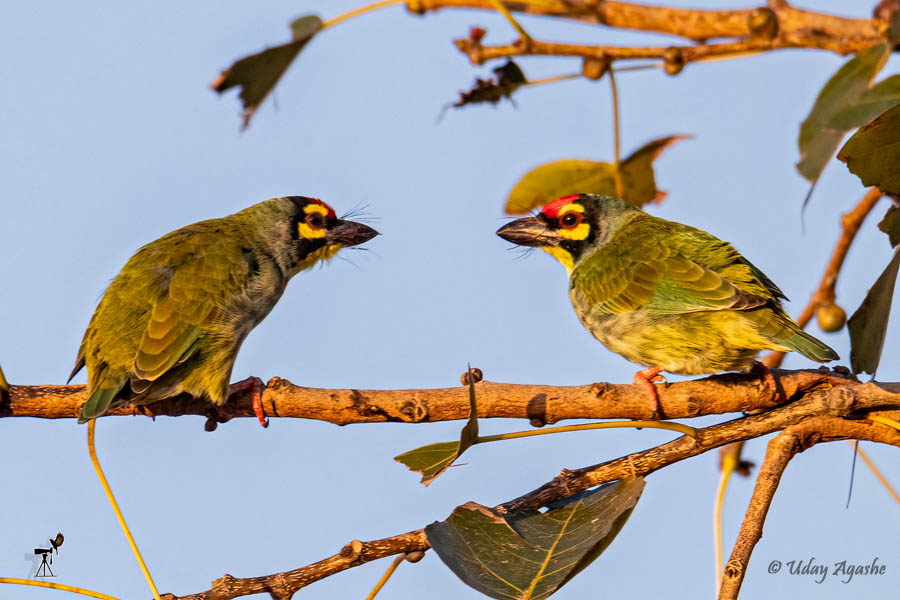
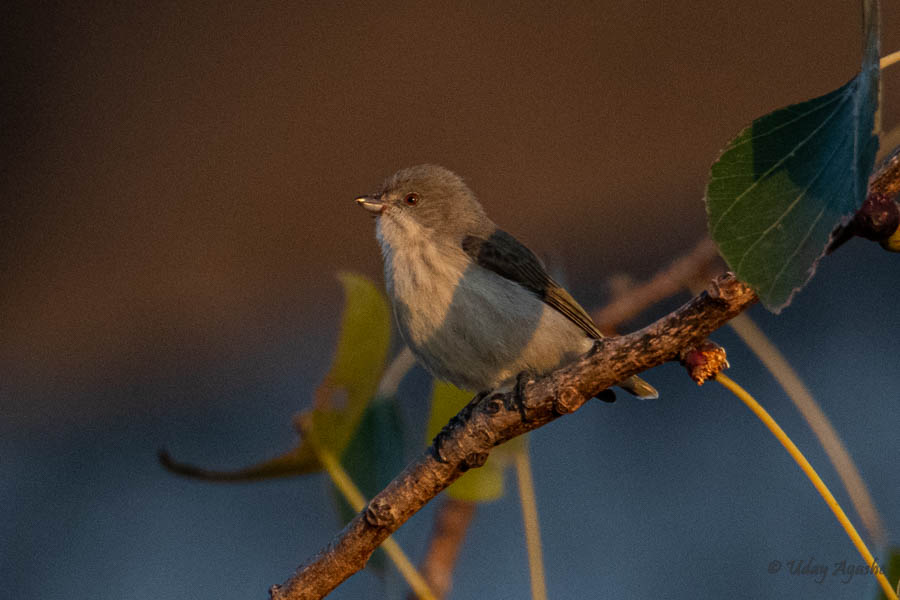
We continued on the terrace for a little over an hour and then had our breakfast before going on the first trail. As we moved around in the small lanes of the Oriya village, we quickly spotted an Red-breasted Flycatcher. That was followed by a few more common birds.
Our target area was about 10 minute walk from our homestay. On reaching there, we all started looking for the Munias in the nearby bushes. We got to understand from Avinash/Clara that these are not very shy birds but they generally move inside the bushes and unless we watch carefully, we may end up not seeing them.
We roamed around in that area for the next hour and a half but there were no signs of the munias anywhere. A lovely sighting of the Brown-headed Barbet made up to an extent. As we were walking back to our homestay, Avinash sighted this barbet perched nicely on a nearby branch and kept moving to nearby branches for the next few minutes allowing us some really good snaps. Just before that, we had also seen a common buzzard flying over us.
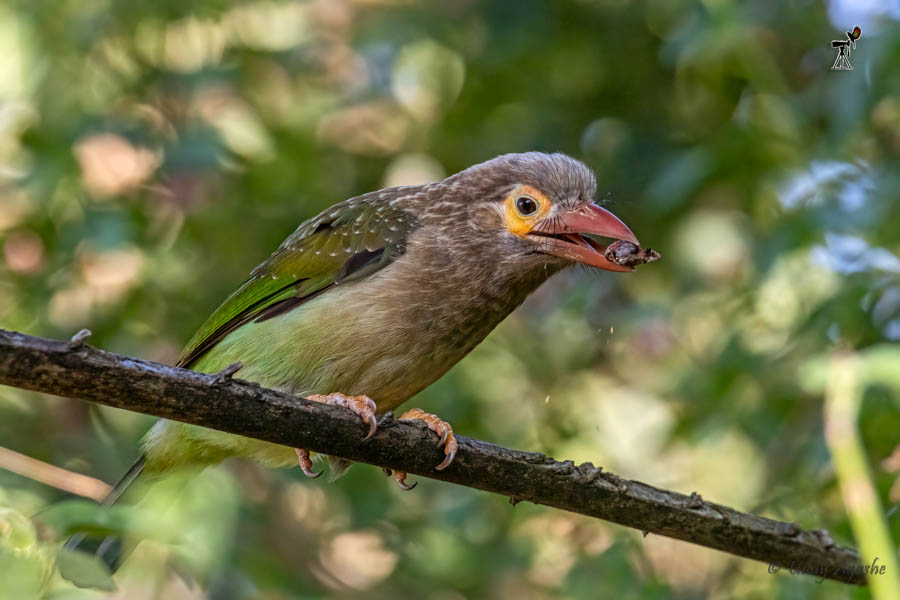
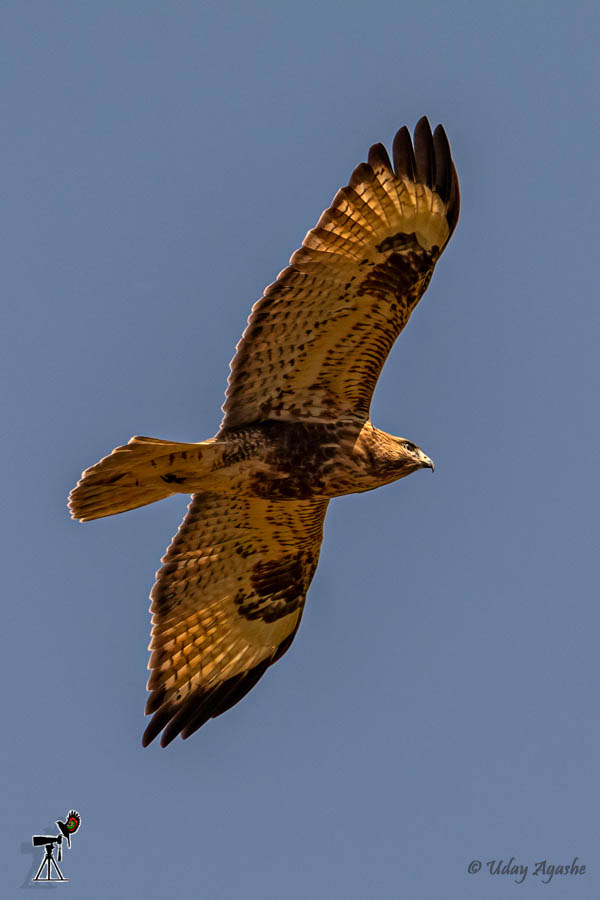
As we were reaching the homestay, Avinash took a call about exploring some more areas a little away from that place. So we hopped onto our minibus and went on the exploration.
That afternoon, we searched 4-5 different places that were a good habitat to find the munias. But other than finding a few common birds and some butterflies, we drew a blank slate.
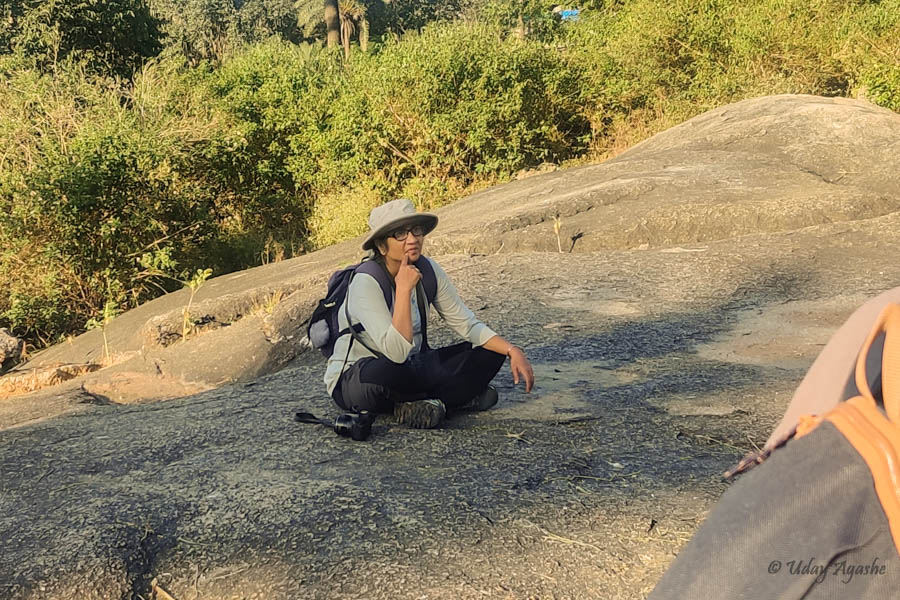
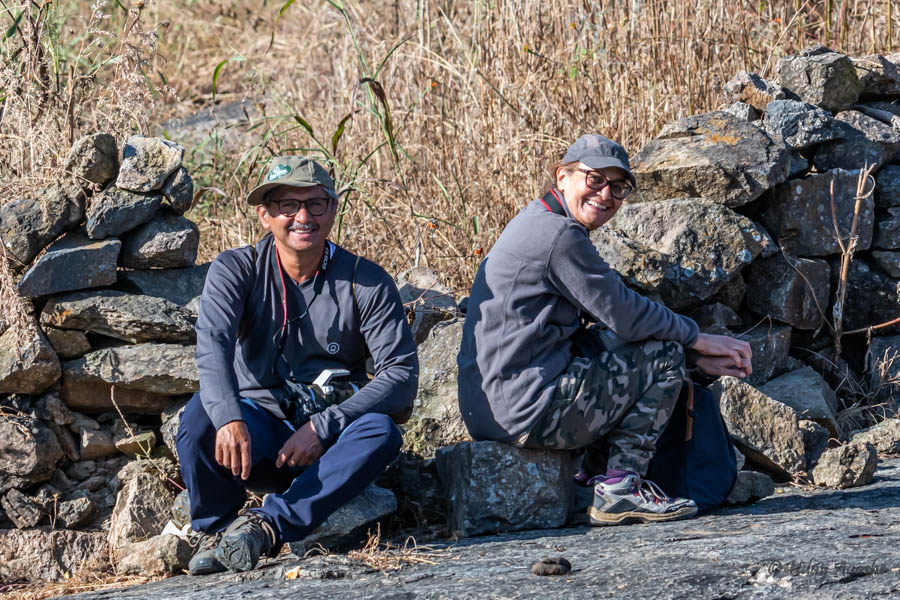
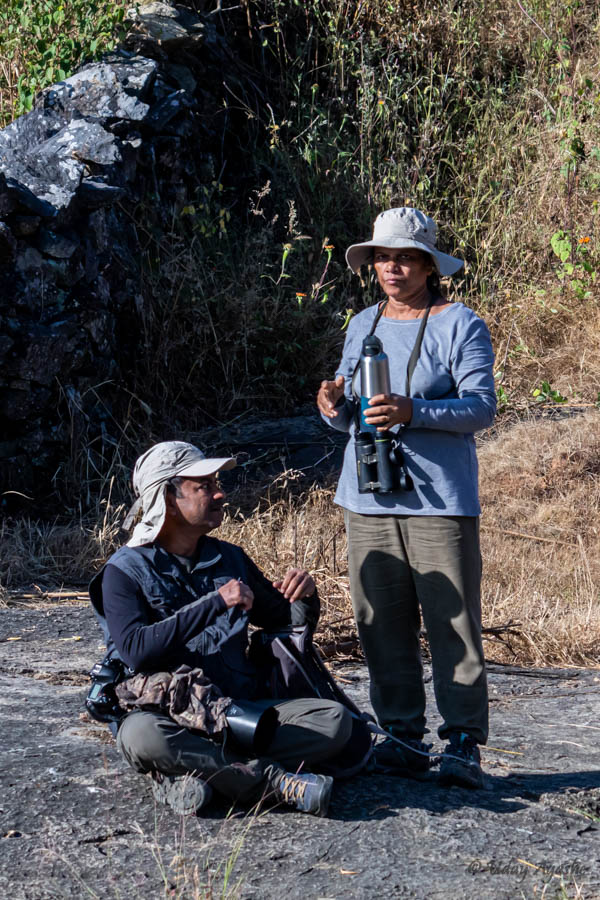
Oh, how can I miss the super exciting sightings of that afternoon? At one point, as we were moving on the road, we saw some people gathered in one place and could also hear their raised voices. On closer inspection, a large snake was lying on the ground and a snake handler was near it.
Avinash himself has rescued a lot of snakes in the past, so he got down to check, and obviously, we all followed him. The moment he announced it was Russel’s viper (one of the 4 deadliest snakes in India), we all got too excited and everyone wanted to go closer for photos. The snake it seems was found in a well nearby (by the local villagers) and the snake rescuer was called for help. He had got the snake out but it was hardly moving. Avinash then conjectured that it was probably in the water for too long and was thoroughly exhausted (as it would have struggled to come out of the water) but it was alive. We all gathered around to take photos (even with our mobile phones now that we knew the snake was not going to make quick movements).
But within a few seconds, there was another large cry heard nearby. The villagers were shouting loudly. We initially thought they were not happy with the snake being kept there (as we were taking photos) but the reason was entirely different. Just as we were watching the snake, about 100 meters away, a leopard attacked a buffalo calf. And all the villagers were shouting intending to shoo away the leopard.
Our daredevil guide was now in the forefront, he ran wildly in the direction of the buffalo herd shouting all along. The word “leopard” was like a steroid injection for us and we all started running in the direction of our guide. In the excitement, some of us even jumped over the viper (that actually was an extremely dangerous thing to do.. even in that exhausted state, the snake could have caused us great harm… Russel’s viper is after all responsible for many deaths in the country).
Now our attention was fully on the leopard. We ran as quickly as possible (with our camera, and tripods) but that leopard was too quick for us anyway. The good part was, with all the commotion, the leopard dropped the calf and ran away into the woods. We only managed to see the frightened calf being surrounded by the adult buffalos.
After that we did search more areas and also scanned a small lake in the vicinity. Here we could see a young grebe being fed by one of the parents, there were a few other ducks as well but other than that, we once again had tough luck.

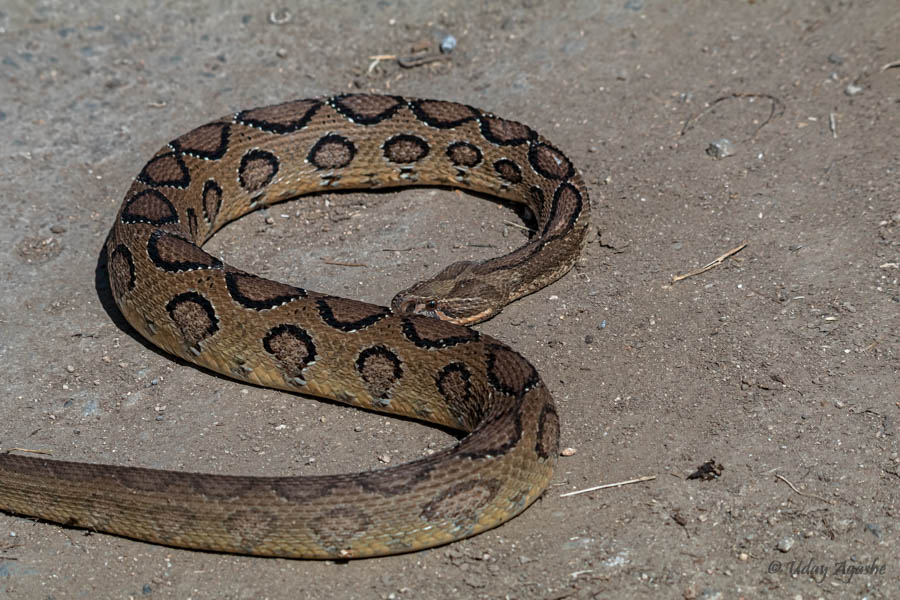

By 1:30 we returned to our homestay for lunch. After lunch, we decided to relax for an hour (from a birding point of view, the hot afternoon hours were anyway not of much use). The food preparations at our homestay were very good and they never wasted much time in delivering it either.
By 3:30, we were out again. Now we decided to move across to the other side of Mount Abu. We drove towards a famous temple called “Kunwari Kanya”. This we understood was very famous among couples and newlyweds. As is the case most of the time, on birding trips we don’t get time to go to any of the popular tourist sites and this was no exception. We just parked our vehicle in the temple's parking area and walked further down in search of the Munias.
For the next 3 hours, we covered a lot of ground but there were absolutely no signs of the munias anywhere.
The only photos that I could click during that time were of a fantail flycatcher, a few parakeets, a pair of Red spurfowls, a tailorbird, and a few butterflies.


What we had imagined being an easy task (of seeing the Green Munia) turned out to be an uphill one. We still had time tomorrow, but the way our guide said a few things, the chances now looked grim to me. He had been seeing the munias since July and was able to see them regularly till about 2 weeks before but after a bout of sudden rains, he had not seen one in the last 2 weeks.
Although no luck with Munia, we had high hopes for the Owl (based on the experience of the earlier evening). So, after dinner, we started once again and went near the temple area around 10 pm.
Once again, the owl did not make us wait. Within a few minutes, it came to the same tree and perched nicely. The only problem this time was, it sat sideways on the tree with no eye contact. And the worst part is we waited for more than 10 minutes, but it just did not turn towards us. In birding one always needs patience but here was one of the strangest things, the bird was there in front of us but we couldn’t take any meaningful photos.
After the long wait, Avinash thought of an innovative approach. On the other side of the tree, there was a concrete structure beside the temple, and a small staircase leading to it. He went up and managed to see the owl from an impossible angle (bending down to see the owl thru the leaves). He then called us one by one (had we huddled together, we might have ended up making a lot of noise). Thankfully, the owl continued to remain in the same position and allowed all of us to get some good photos with good eye contact.
As we got down from that kachcha structure, we heard the call of another owl species (the Indian scops owl). Our excitement was at its peak. We waited for a few seconds and then we got a jackpot. Not one but there was a pair of scops owls in the tree. We quickly put our torch in that direction and managed to get them together before they both disappeared into the darkness.
Thankfully the owl sighting was some consolation for the otherwise disappointing day.

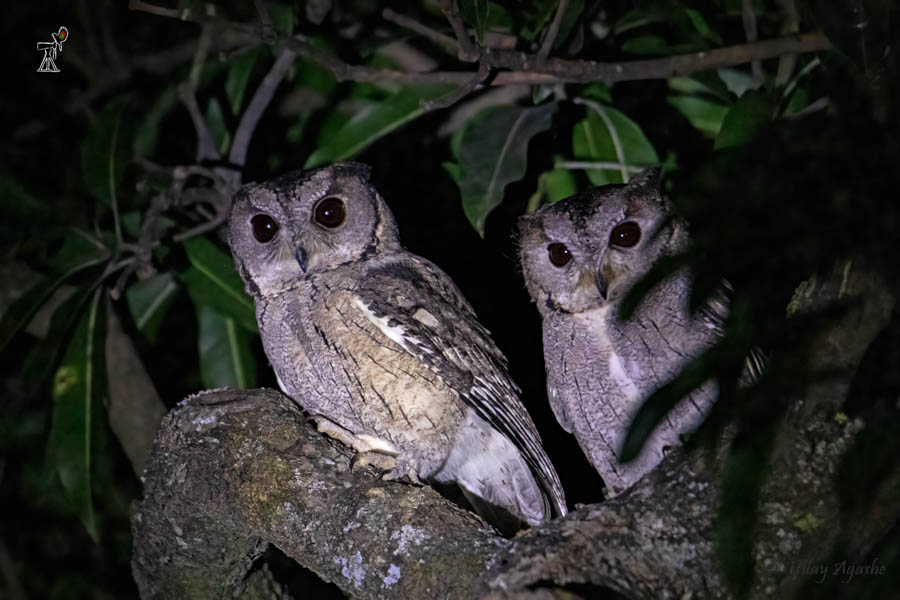
The Last Day: Desperate hopes
Today, we did not spend much time in terrace birding but instead decided to explore some more habitats for the munia. Once again, we started with a lot of enthusiasm. Till breakfast, we covered newer areas as well as some of the areas that we had visited the previous day.
Our initial plan for the day was to return to Ahmedabad to take the night train but that got changed later as there was a train from Abu Road station as well. But this meant, we had booked the hotel only till morning and we had to vacate it by 9 (extended to 10).

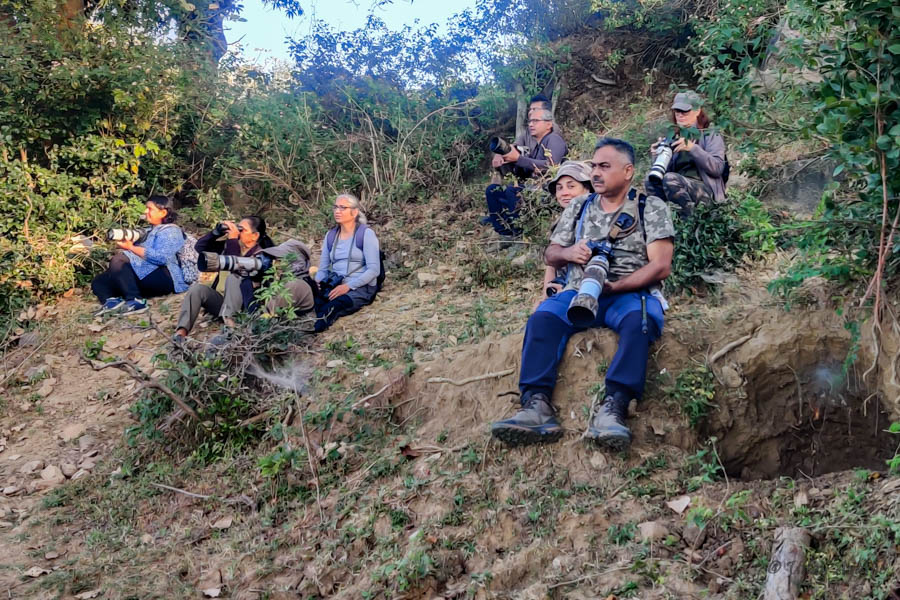
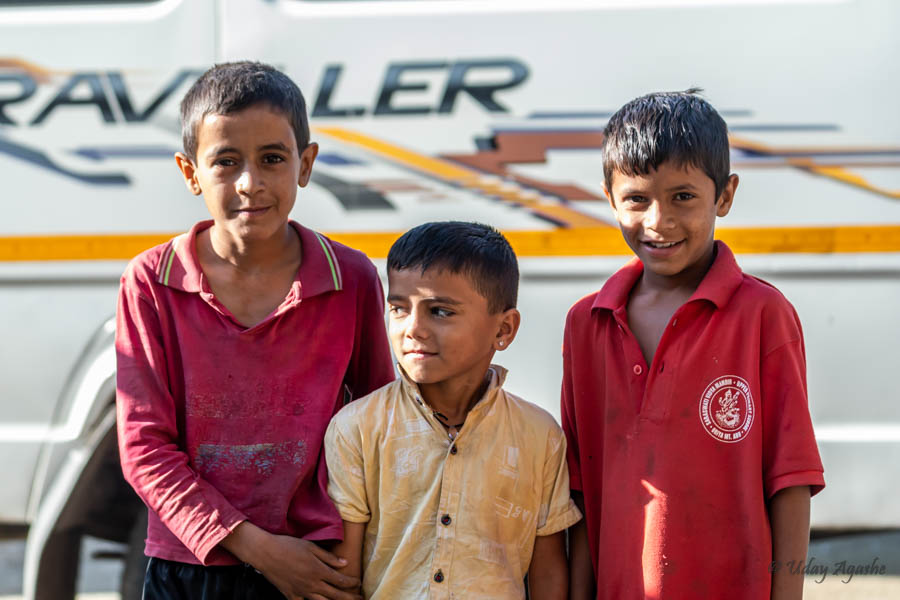
We quickly had our breakfast, packed our bags and kept them in a common area, and then moved out for the next session. Yesterday evening, at one place we heard some kids talking about Munias. They were ready to show us the place in the morning, so we headed to that area. Overall Mount Abu is a hilly area and here we were at the top of a small hillock and the boys were going to a stream down below.
As it was a considerable effort to reach there, Avinash decided to explore it first and if found suitable, we could all follow. The rest of us decided to wait at the top. But other than a lone Black-shouldered kite, there wasn’t anything worthwhile here. Avinash came back in some time but even there he could not find any munia.
It was getting close to noon, so we decided to head back to our homestay. We were to have our lunch there. On the way back, we got to see a woodpecker, white-bellied drongo, and a few butterflies.
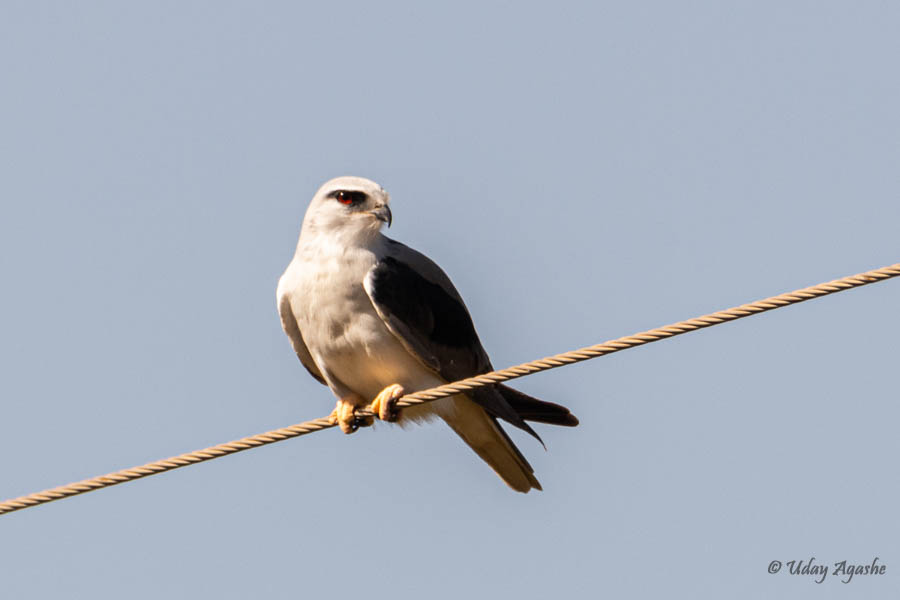
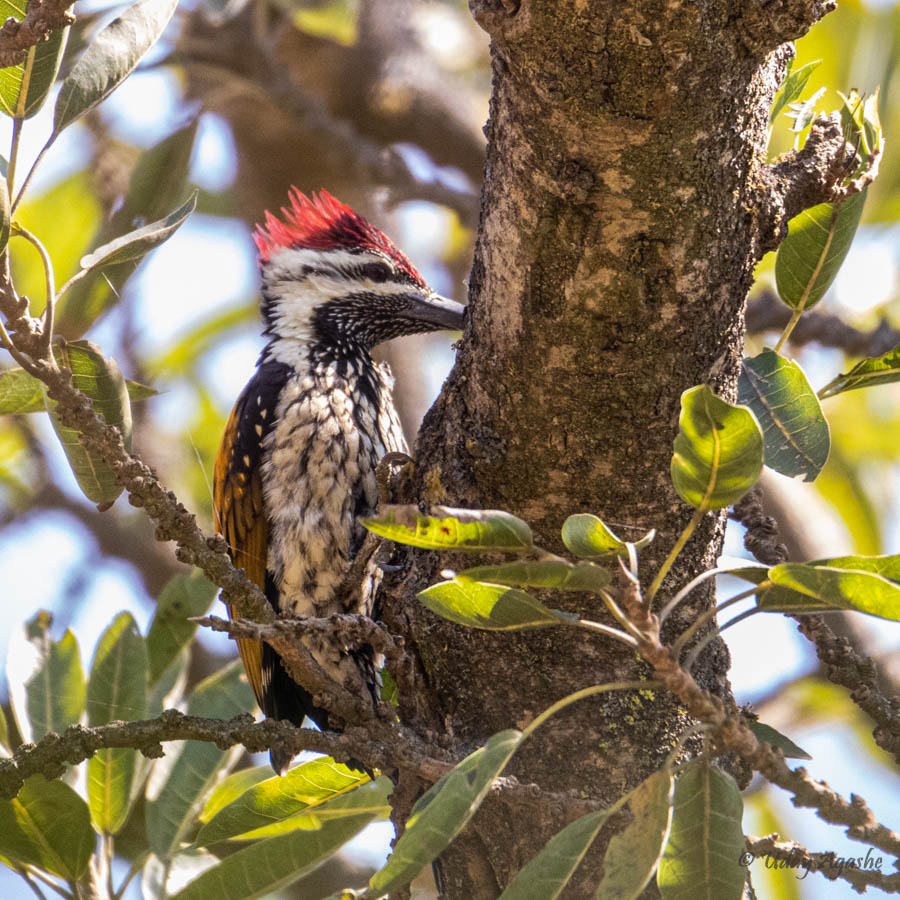
After lunch, we had a new problem. As I had mentioned, our initial plan was to travel back to Ahmedabad and 2 of our friends had booked train tickets accordingly. And since our mini-bus was taking them to Ahmedabad, we had to look for a new vehicle (to have another trail in the evening and then travel to the Abu road station). Another problem was, the rooms were already booked by some other group so we could not even wait in the common area of the homestay. So for close to an hour, we were stranded outside in Oriya village (found some shade below a huge banyan tree and passed the time).
Avinash then arranged for 2 Boleros (enough as we were 9). We quickly dumped our luggage in the vehicles and went to try our luck for the very last time. By then, we had already talked to our local guide and asked him to update us about the sightings in the coming days/ months (we planned to make a day trip if the munias are to be seen on regular basis).
As we had a smaller vehicle, our guide took us to another hill, the roads were small so he could not take the tempo traveler here. Here our driver was very enthusiastic. Although it was a typical tourist vehicle, he was aware of the Green Munias and assured us that we will surely see the Munias there. “Mount kabhi nirash nahi karata” were his exact words.
This area was a little different. It had a nice golf-course-like lawn that was surrounded by hills. We split into 2 teams to explore more areas as this was our last chance. We could see some bird activity at one particular place close to a tiny water pond. So some of us decided to camp there. Soon we could see the fantails, a few red-breasted flycatchers, black redstarts, and some warblers. A little later Avinash told us to click pictures of a sparrow-sized bird (was fairly at a long distance), in fact, a pair that was moving on the lawn. It was the White-capped Bunting.
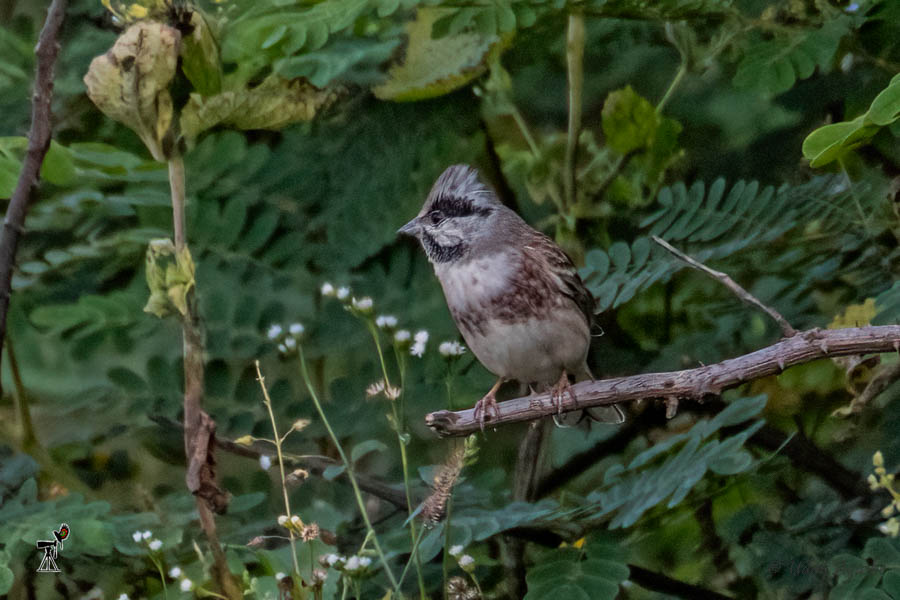

This bunting was another highlight bird of the tour so we were happy with that. By now, the day was getting over and the light had started reducing. We were all aimlessly roaming around and then suddenly we heard the much-awaited cry from Avinash… MUNIA…..
That was like music to our ears, we all looked in the direction Avinash was pointing. There was a small bird in flight and we really could not make out whether it was Munia but if Avinash said, then it has to be.. we were all sure about that. That bird flew from one side to the other without perching anywhere near.
By then our hopes had suddenly increased 1000 times. We also called the other group (roaming in different parts) and everyone started looking for the munias. Slowly we started seeing some movement in the trees where the munia had disappeared. 2-3 times, we saw them flying from one tree to other but they were far off. Time was ticking at super speed and we had to catch the train. Although we could not photograph it, we all at least had seen the Munia.
We kept waiting patiently and a little later, one of the Munia decided to perch on the other side of the lawn from where we could see it. We all quickly pointed our cameras in that direction and started clicking desperately. Just 4-5 clicks and then the munia disappeared into the thick canopies. But we now had photographic proof that we had at least seen it (the photo quality was not good but that was alright).
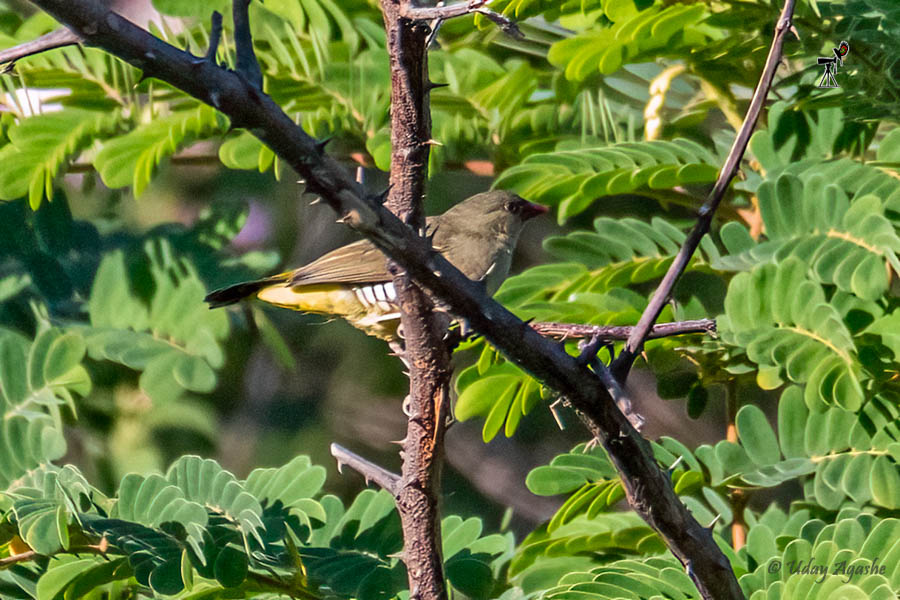
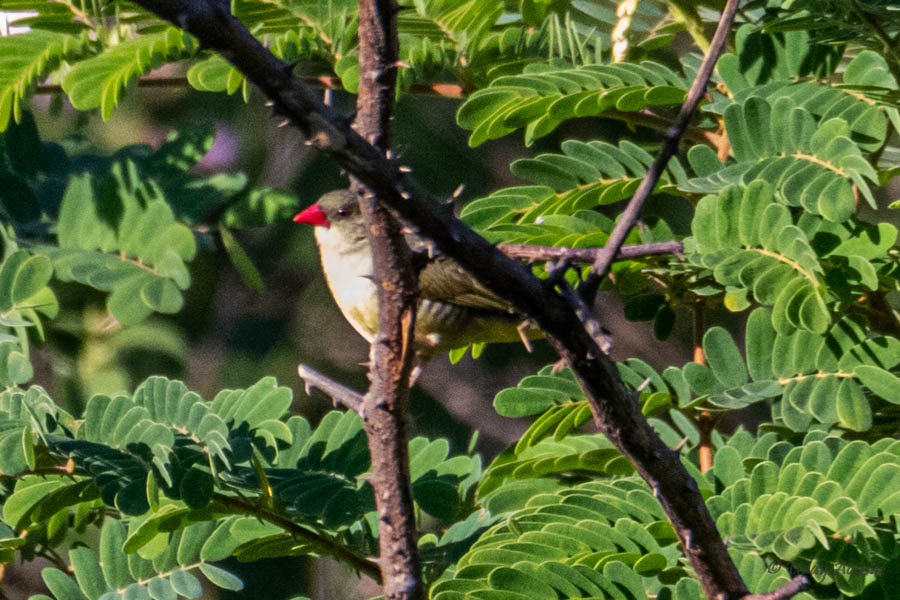
With relaxed minds, we all lined up for a group photo. Don’t you see the joyous expression on everyone’s face?

We continued there for 15-20 minutes more in the hope of getting better photos but that did not happen. The return journey to Abu road station and then onwards to Home was routine.
The last hour of the trip turned out to be the best. It just reminded us that with nature, one cannot take anything for granted. Before reaching Abu, some of us had even planned to visit Udaipur for some recent owl sightings there (the plan was, we only need a couple of hours in Abu to see the Munia, so we would be free to make this trip).